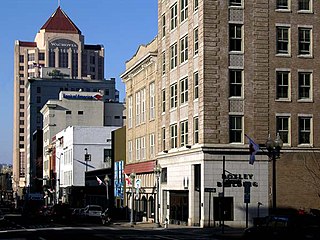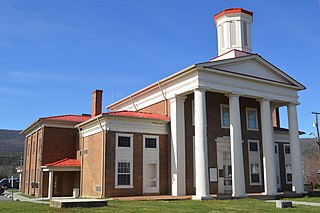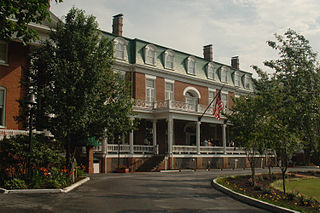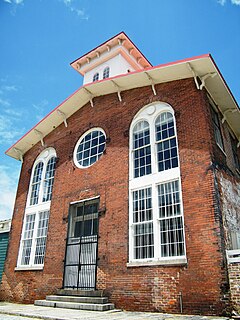
The Roanoke Downtown Historic District is a national historic district located in the Downtown Roanoke area of Roanoke, Virginia. It encompasses 122 contributing buildings. It includes a variety of commercial, institutional, social, and governmental buildings and structures from the late 19th century to the mid-20th century. Notable buildings include the Roanoke City Public Library, the YMCA Central Branch Building, First Christian Church (1925), the Central Church of the Brethren (1924), Tomnes Cawley Funeral Home (1928), Thomas B. Mason Building (1961), Peerless Candy Co., City Hall / Municipal Building (1915), Roanoke Times Building (1892), Anchor Building / Shenandoah Building (1910), Greene Memorial Methodist Church (1890), and United States Post Office and Courthouse (1930). Located in the district are the separately listed Patrick Henry Hotel, the Boxley Building, the Campbell Avenue Complex Historic District, Colonial National Bank, and First National Bank.

Greenway Historic District is a national historic district located near Boyce, Clarke County, Virginia. It encompasses 432 contributing buildings, 23 contributing sites, and 35 contributing structures. The districts includes the agricultural landscape and architectural resources of an area distinctively rural that contains numerous large antebellum estates. The district contributing buildings are primarily farm and estate residences and their associated outbuildings. Other contributing buildings include three schools, five churches, two mills, a gas station, a restaurant, and a railroad station. The contributing structures are mostly corncribs and the contributing sites are mainly cemeteries and ruins of historic buildings. The district contains ten individual properties and two historic districts already listed on the Virginia Landmarks Register and National Register of Historic Places.

New Castle Historic District is a national historic district located at New Castle in Craig County, Virginia, United States. It encompasses 111 contributing buildings, 2 contributing sites, and 1 contributing object in the central business district and surrounding residential areas of New Castle. The focal point of the district is the Craig County Courthouse. It was built about 1850, and is a temple-form structure with shallow gable roof, a two-story tetrastyle Greek Doric order portico and wooden hexagonal cupola. Associated with the courthouse is the sheriff's house and old jail. Other notable buildings include the Central Hotel, First National Bank Building, Layman Insurance Agency building, Givens-McCartney House (1837), Caldwell-Berger-Lamb House, Bank of New Castle, Farmers and Merchants (F&M) Bank of Craig County (1917-1920), Wagener Brothers Store, Bill Caldwell General Store, George W. Craft, New Castle Methodist Episcopal Church, and Masonic Temple (1940).

Rocky Mount Historic District is a national historic district located at Rocky Mount, Franklin County, Virginia. It encompasses 211 contributing buildings, 2 contributing sites, 1 contributing site, and 2 contributing objects in the central business district and surround residential areas of Rocky Mount, county seat of Franklin County. It includes residential, commercial, institutional, and governmental buildings dated from the early- to mid-19th through early 20th centuries. Notable buildings include the Rakes Building (1929), N&W Freight Depot, Mount Pleasant (1828–1829), The Taliaffero Building (1827–1828), The Grove (1850), McCall House, Lodge Rooms (Colored), Trinity Episcopal Church, Rocky Mount Presbyterian Church, Baptist Church (Colored), N. Morris Department Store / Bryd Balm Company, Franklin County Courthouse (1909), Franklin County Jail (1938), Franklin County Library (1940), Rocky Mount Municipal Building (1929), and a Lustron house known as the Davis House (1949). Located in the district and separately listed are the Woods-Meade House and the Greer House.

South Boston Historic District is a national historic district located at South Boston, Halifax County, Virginia. The district includes 594 contributing buildings and 7 contributing structures in the Village of South Boston. It consists of industrial, commercial, and residential building types dating from the mid-19th century to the present. Notable buildings include the C.H. Friend School, New Brick Warehouse, Planters and Merchants Bank, Halifax Cotton Mill, R.J. Reynolds Tobacco Company tobacco prizery, former Liggett-Meyer Tobacco Company tobacco prizery, the Parkinson Block (1899), First Presbyterian Church (1887), First Baptist Church, and Mt. Olive Baptist Church.

Town of Halifax Court House Historic District is a national historic district located at Halifax, Halifax County, Virginia. The district includes 172 contributing buildings, 1 contributing site, 13 contributing structures, and 1 contributing object in the Town of Halifax. Resources include government, commercial, residential, religious, educational and industrial buildings that date from the early-19th Century to the mid-20th century. Notable buildings include the Rice House, Edmunds/Lewis Office (1869), People's Bank, Beth Car Baptist Church (1892), Christ Episcopal Church, Saint Luke's Christian Methodist Episcopal Church, Dr. Carter House, County Office Building (1915), Town of Halifax Swimming Pool (1930s), Municipal Building/ Fire Station (1950), Halifax Roller Mills (1915), Halifax Planing Mill, Halifax Department Store (1949), and Randolph Theater. Also located in the district is the separately listed Halifax County Courthouse.

Glasgow Historic District is a national historic district located at Glasgow, Rockbridge County, Virginia. The district encompasses 43 contributing buildings, 3 contributing sites, and 1 contributing structure in the central business district of the town of Glasgow. It includes a variety of residential, commercial, and institutional buildings dating from the 1820s to 1920s, with most structures from the 1890s. Notable buildings include the Rebecca Salling House, First Baptist Church, the former Glasgow Baptist Church, St. John's Episcopal Church, Blue Ridge Building, and Glasgow Masonic Temple (1891-1892).

Marion Historic District is a national historic district located at Marion, Smyth County, Virginia. The district includes 361 contributing buildings, 2 contributing sites, and 1 contributing object in the central business district and surrounding residential areas of Marion. It includes a variety of residential, commercial, institutional, industrial, and governmental buildings primarily dating from the mid-19th to mid-20th centuries. Notable buildings include the Sheffey Loom House, Odd Fellows Lodge, Look & Lincoln Wagon Factory warehouse, the Beaux-Arts style Marion County Courthouse (1905), Mt. Pleasant Methodist Church, Courtview Building (1890s), Marion High School (1907-1908), Marion Junior College (1912), the Overall Factory, Weiler Building, Bank of Marion (1922), Royal Oak Presbyterian Church (1923), Marion Municipal Building (1935), Marion Post Office (1936), and a Lustron house (1948). Also located in the district are the separately listed Hotel Lincoln, Lincoln Theatre, Marion Male Academy, and Norfolk & Western Railway Depot.

Old Kentucky Turnpike Historic District is a national historic district located at Cedar Bluff, Tazewell County, Virginia. The district encompasses 35 contributing buildings, 3 contributing sites, and 3 contributing structures along Indian Creek Road and Indian Creek. They date from the late-19th to mid-20th centuries. Notable resources include the concrete bridge, steel railroad trestle, Cecil-Watkins House, Ratliff House, Cedar Bluff Presbyterian Church, the boyhood home of Governor George C. Peery (1873–1952), Thomas Cubine House, Gillespie House, the Old Cedar Bluff High School, Cedar Bluff High School (1906), and the Old Cedar Bluff Town Hall. Also located in the district is the separately listed Clinch Valley Roller Mills.

Abingdon Historic District is a national historic district located at Abingdon, Washington County, Virginia. The district encompasses 145 contributing buildings, 2 contributing site, and 13 contributing structures in the town of Abingdon. It includes a variety of residential, commercial, and institutional buildings dating from the late-18th century to the mid-20th century. Notable contributing resources include Sinking Spring Cemetery, William King High School (1913), General Francis Preston House (1832), Martha Washington Inn, Barter Theatre, the Virginia House, Alexander Findlay House (1827), Gabriel Stickley House, Ann Berry House, Washington County Courthouse (1868), Rev. Charles Cummings House, and James Fields House (1857). Located in the district and separately listed are the Abingdon Bank and Dr. William H. Pitts House.

The Danville Tobacco Warehouse and Residential District is a national historic district located at Danville, Virginia. The district includes 532 contributing buildings, 3 contributing sites, and 2 contributing structures in the city of Danville. The district reflects the late-19th century and early-20th development of Danville as a tobacco processing center and includes residential, commercial, and industrial buildings reflecting that growth. It also includes archaeological sites related to early Native American settlements in the area. Notable buildings include the American Tobacco's Harris Building, the Imperial Tobacco Company Building, Cabell Warehouse, Patton Storage Units, Crowell Motor Company, Municipal Power Station (1912), Riverside Cotton Mill #1 (1886), and a variety of "shotgun" houses and bungalow workers housing. Located in the district are the separately listed Danville Municipal Building and Danville Southern Railway Passenger Depot.

Dan River Inc. Riverside Division Historic District and Dan River Mill No. 8 is a national historic district located at Danville, Virginia. The district includes 23 contributing buildings and 13 contributing structures in the city of Danville. The district includes buildings and structures associated with the Riverside Division, one of two historic textile mill complexes in Danville developed by Dan River Inc. and its predecessor, Riverside Cotton Mills. The building and structures are characterized by multistory industrial buildings of mostly brick construction dating from the 1880s through the 1910s. Dan River Mill No. 8 is a four-story, reinforced concrete building constructed in the 1920s.

Franklin Historic District is a national historic district located at Franklin, Virginia. The district includes 226 contributing buildings and 1 contributing site in the city of Franklin. It includes residential and commercial buildings that were primarily built during the late 19th- and early 20th-century. Notable resources include the Poplar Springs Cemetery, Camp Family Homestead, the former W.T. Pace Hardware Store, former U.S. Post Office (1916), Franklin Professional Building (1920s), Lyons State Theatre (1930s), Pretlow Peanut Company Warehouses, High Street Methodist Church (1890s), Emmanuel Episcopal / Grace Lutheran Church, and Franklin Elementary School (1922). Located in the district is the separately listed The Elms.

Petersburg Old Town Historic District is a national historic district located at Petersburg, Virginia. The district includes 174 contributing buildings located in the oldest section of Petersburg. It includes a varied collection of late 18th- through 20th-century architecture. Notable buildings include the Strachan-Harrison house, the John F. May house, South Side Railroad Depot, High Street United Methodist Church, Church of Christ (1925), and the Powell Manufacturing Co. Located in the district and separately listed are the Appomattox Iron Works, City Market, Exchange Building, Farmers' Bank and Nathaniel Friend House.

The Carver Residential Historic District is a national historic district located at Carver, Richmond, Virginia. The district encompasses 312 contributing buildings and 1 contributing site located west of downtown Richmond. The primarily residential area developed starting in the mid-19th century. The buildings are in a variety of popular 19th-century and early 20th-century architectural styles, including Gothic Revival and Greek Revival. Notable buildings include the Hardin Davis House (1842), Amanda Ragland House (1843), Reuben Lacy House (1859), Rueben T. Hill House (1900), George Washington Carver Elementary School (1887), Moore Street Baptist Church (1909), Baughman Brothers/Biggs Antique Company building (1924), and the T&E Laundry Company Building.

Salem Avenue–Roanoke Automotive Commercial Historic District is a national historic district located of Roanoke, Virginia. It encompasses 59 contributing buildings in the southwestern part of the City of Roanoke. The district includes a variety of buildings having automotive, warehouse, light industrial and residential uses. Most of the buildings are small-scale, one or two-story brick or concrete block buildings, with the majority built between about 1920 and 1954. Notable buildings include the former Enfield Buick Dealership, Lindsay-Robinson & Co. Building (1918), Fulton Motor Company Auto Sales & Service (1928), Lacy Edgerton Motor Company, Roanoke Motor Car Company, and Fire Department No. 3 (1909).

Wharf Area Historic District is a national historic district located at Staunton, Virginia. The district encompasses 22 contributing buildings and 4 contributing structures. It is a warehouse and commercial district characterized by rows of late-19th century and early-20th century storefronts and an elongated plaza framed by small warehouses. The buildings are characteristically two- and three-story, brick structures in a variety of popular architectural styles including Greek Revival, Federal, and Queen Anne. Notable buildings and structures include the Railroad Water Tower, American Hotel, John Burns Building (1874), Erskine Building (1904), and Chesapeake and Ohio Railroad Station (1902).

Suffolk Historic District is a national historic district located at Suffolk, Virginia. The district encompasses 514 contributing buildings, 3 contributing structures, and 3 contributing objects in Suffolk. The district includes a variety of residential, commercial, governmental, and institutional buildings. They are in a variety of vernacular and popular 19th and 20th century architectural styles including Greek Revival, Queen Anne, and Bungalow. Notable buildings include the Allmond Building (1914), Macedonia A.M.E. Church, National Bank of Suffolk (1914-1920), the Old Post Office, old Nansemond County Courthouse, John Granberry house, Richard Seth Eley House (1878), Jones Building, Suffolk Towers, Virginia Apartments (1918-1920), Causey-Kendrick house (1882), Masonic Hall (1911), Suffolk High School (1922), Jefferson High School (1911), old Methodist Church (1861), St. Paul's Episcopal Church (1895), Suffolk Christian Church (1893), and Congregation of Agudath Achin. Located in the district are the separately listed Phoenix Bank of Nansemond, Professional Building, and Riddick House.

West End Historic District is a national historic district located at Suffolk, Virginia. The district encompasses 201 contributing buildings and 93 contributing structures in a primarily residential section of the city of Suffolk. The district includes buildings dating from the last decade of the 19th century through the first four decades of the 20th century in a variety of popular architectural styles including Queen Anne and Folk Victorian. The residences were developed to support the growing upper-, middle-, and working-class populations. Notable buildings include the J. C. Causey, Jr. House, Oxford United Methodist Church (1922), and West End Baptist Church (1938).

The Winchester Historic District is a national historic district located at Winchester, Virginia. The district encompasses 1,116 contributing buildings in Winchester. The buildings represent a variety of popular architectural styles including Late Victorian and Italianate. They include residential, commercial, governmental, industrial, and institutional buildings dating from the 18th to mid-20th centuries. Notable buildings include the A.M.E Church (1878), Masonic Lodge and Gray and Eddy Building, First Presbyterian Church, Farmers and Merchants Bank (1902), Frederick County Courthouse (1840), Grace Lutheran Church, Friendship Fire Hall (1892), John Kerr School, City Hall (1900), Lewis Jones Knitting Mill (1895), Tidball Residence, William F. Hottle Residence, McGuire Residence, and Robert Long House. Located in the district are the separately listed Thomas J. Jackson Headquarters, Fair Mount, Handley Library, Adam Kurtz House, and Daniel Morgan House.

























